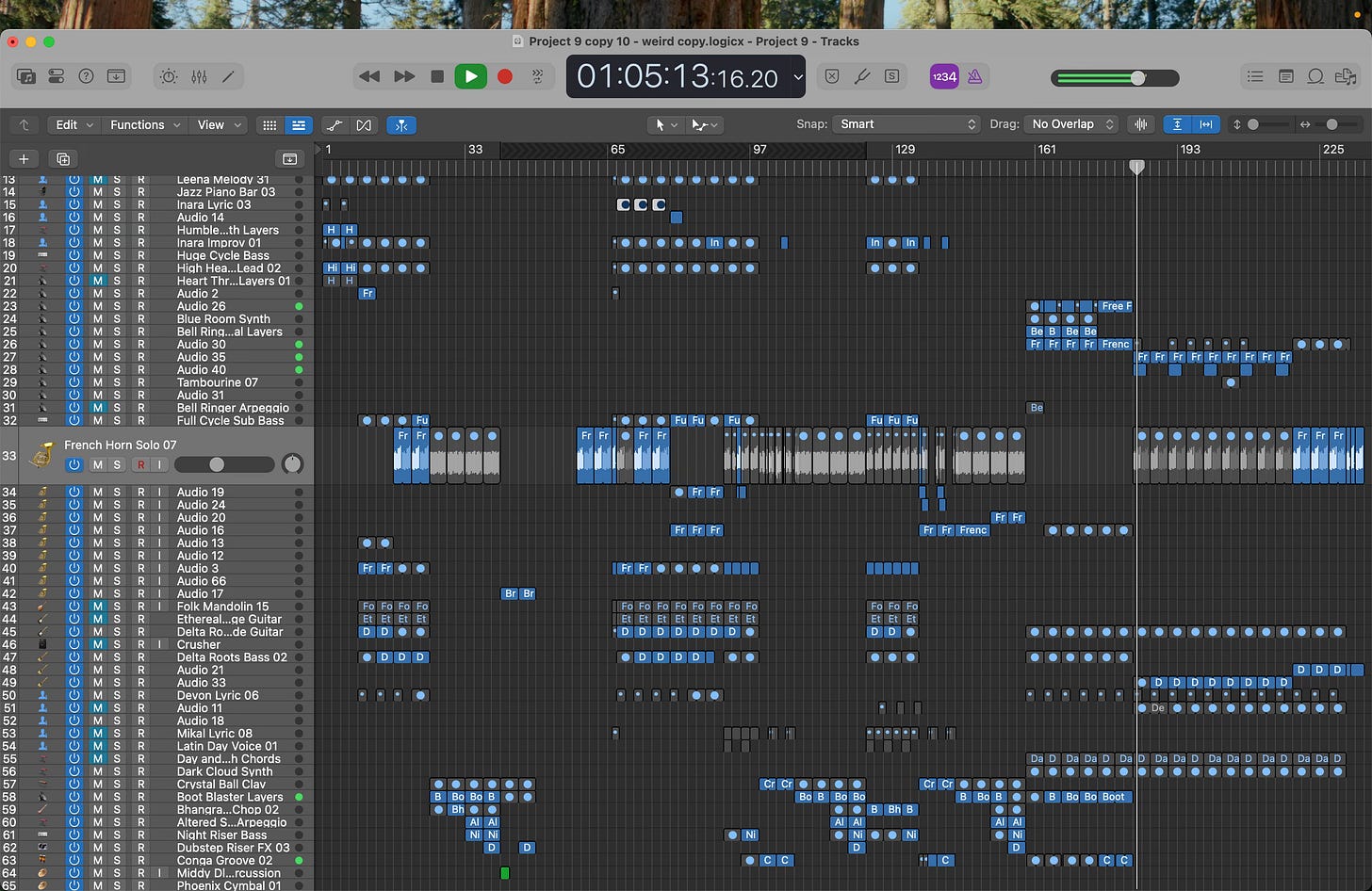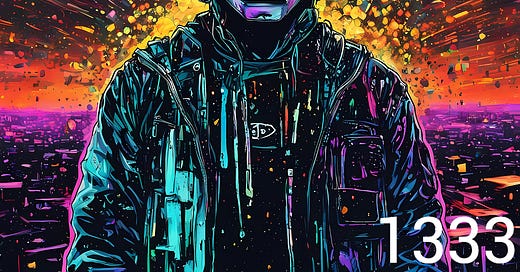Welcome to the third post in a new section of my publication — Freeform! This week I’ll be discussing the making of my album, dropping tomorrow, May 9.
You can get it via the links below or stream it to your heart’s content tomorrow, wherever music can be found.
If you want to adjust which sections of my publication you subscribe to, you can make changes to your account here. If you want to make sure you get these emails, add this email sender to your contacts.
Without the Substack community, 1333 would not exist. The album was born on Jan 29, 2025 with this comment:
So thank you,
, for incepting the idea. I saw the comment, said my thanks, and dismissed the idea immediately.Albums are a pain in the ass. First, you have to make music. Making music is really hard. It’s one of those things that looks easy until you try. And try. And try. And try.
It’s especially hard when you don’t know what the hell you’re doing.
I am a naive musician. I have no formal training (unless you count some abortive piano lessons as a kid 🤷♂️). I can’t read music. I can’t play an instrument. I don’t know any music terminology other than note, bpm, time signature(?), arpeggio.
Key! I know the keys. A. B. C. C# etc. You know. The keys. If you mix these up, everything will sound like the din of hell.
So. What can I do?
Well. I can kind of see the notes. Other musicians have alluded to this phenomenon — where sounds appear as colors and shapes to them. I’ve been told this isn’t exactly synesthesia, but just the brain doing its usual weirdness. I have no idea if it’s innate or just something I acquired through practice. As a kid, my circumstances required frequent distraction, so I would often play music in my head as best I could from memory.
This visualization is a very useful skill when paired with technology.
One day, on a whim, at the tender age of twenty, having never made any music ever, I went to my university’s computer lab and started playing around with GarageBand. The result was my first song: John Oaks. (I don’t know why I called it that, other than that’s the name that came to me.)
Not bad for my first time. Not great.
I see this as vague layers of blue and foamy white with the harpsichord as a kind of diamond. It’s hard to describe exactly what I’m experiencing — and it’s not that I don’t hear the music. It’s more like as the music plays, I see the shape or the patterns unfolding and the colors blooming in my mind’s eye.
That element of shape and color is what I like to play with. Because that can go into some very interesting and surprising places, which are sometimes harder to find with just the sounds alone.
For comparison, here’s a song coming out tomorrow: You Make Me Feel
So there’s been some improvement over the past two decades. You Make Me Feel is exploding with different colors, which is what I like, and it has some fascinating interleavered shapes, almost like cardboard waves in a theatre set as the two vocals come together at the very end.
One aspect that’s pretty consistent with the visualizations is that delay and reverb has a “blurring” effect, almost like a watercolor. I like watercolors so I use a lot of delay, and I like to contrast it with hard and sharp-edged sounds. Distortion also has an effect of adding a gritty texture to the hard lines.
The technology of DAWs — Digital Audio Workstations — is perfect for someone who likes to play around with lots of shapes and sounds and fit them all together into new and interesting patterns. When I started, I was using a few hundred loops and midi samples that came with GarageBand.
Today Logic, the big brother to GarageBand, comes with thousands of free to use samples. With services like Splice and LANDR I can access hundreds of thousands of samples for a few bucks a month. Not to mention the ability to create my own instruments, record my own vocals, and create my own midis. I can drag the notes around a virtual piano roll until they sound good. I don’t have to know what they are to know what they do.
Here’s what these songs look like in the DAW. From various WIPs from various ages.




You can see with the DAW, music creation starts to look a lot more like an easel and canvas. It really is as simple as finding the sounds you want and then dragging them around until they click into the shape you want.
It only takes a few dozen or hundred hours depending on the song. For me, I can fall into a trance doing this. I can wake up, drink a cup carafe pot of coffee and get sucked into the world of sounds and colors, not eat, not notice the clock, lose the whole day doing it. I used to be late, miss appointments, parties, dates, forget to send emails, because I was so absorbed.
That’s also why my songs tend to have weird structures. I’m listening to the song so many times over the course of making it I crave novelty. I’m trying to surprise myself and keep myself interested. If I can predict where the song will go then that’s the last place I want to take it.
Once a song is more or less arranged, one must polish it. Listeners expect a level of polish these days — and why wouldn’t they? One must mix the song for stereo, moving the various tracks to the left and right speakers to create a spectrum. One must adjust the EQ so the wavelengths of the instruments don’t crowd each other out, so the drums don’t trip over the bass and the flutes don’t pop your speakers (or eardrums). Then one must do it again with mastering — the final draft of the song, as it were.
Doing all this for one song is a lot of work. To do it for ten or more songs — I thought it was impossible. I thought I would only ever release singles. Plus, when you release a single, it stands on its own. When you release an album, all the songs have to relate to each other and equal the level of quality.
(As an aside: release is the right word. It is a release, to get the music out. Otherwise it clings to you and weighs you down.)
Then I saw that comment. And I dismissed that comment instantly. Because. Because an album was a lot of work. Because I didn’t know what the hell I was doing. Because there was a safety in just putting out singles that could be judged on their own. Because albums were for musicians and I couldn’t make music without a computer, so I wasn’t a musician. Because I used samples. Because my tracks were disorganized. Because I named my songs figgledeedoo copy 17. Because I didn’t (don’t) really know how compressors worked. Because. Because. Because.
Because these were all excuses. And in the echo chamber of my own fear, they appeared valid. But the moment they were exposed to the outside world — when someone commented on a song I had made — their persuasion shriveled and succumbed.
I began to think — well, what is actually stopping me here?
And I began to take stock of what I had done. And what I had done was quite a lot. Hundreds of songs in various degrees of completion. I started to label them, and organize them, and find the ones that were the most done that fit together. More parts to play with, more shapes and colors, in an even grander pattern.
I learned. I learned skills I thought were too technical, too difficult, too much the province of a real musician. Things that were actually much easier to learn than the skill of arranging the colors and shapes.
I found twelve songs at first. And then I found one more. An old song, in a forgotten folder. But done enough I could make it work. Thirteen songs. Thirty-three minutes.
1333.
Turns out you can still do something, even if you don’t know how.
Lastly, when I went digging around looking for the comment that inspired me, I was touched at all the people who had gone out of their way to comment on my songs and offer me encouragement. None of you had to do that and I appreciate it. You never know what one stray comment can do.
Thank you 🙏
And if you find it interesting to learn about the music creation process, please let me know in the comments.







Hey Andy, I wanted to drop you a line to say thanks for the mention and I’m really glad my comment had an impact and was inspiring to you.
Thought you might be interested in a little backstory to it: partly why I said what I said is because I too, once upon a time, was tinkering around with making EDM music and figuring out what the hell to do with it. That project’s long since expired and relegated to the deep, dark cobwebbed corners of my hard drive, but I learned a lot and had a lot of fun along the way.
It’s really interesting to me how your experience teaching yourself to program and so on with no traditional music training mirrors my own. I’ve no training, and while I don’t have borderline synesthesia phenomenon going on, I did find that I could ‘sense’ the music while I was creating it. I sort of followed my musical intuition wherever it went, and it went to pretty cool places, all told. At the time I was messing around with Fruity Loops, sticking notes on the Piano Roll and using template synths, but before that I’d been using GarageBand like you, too. I watched YouTube videos on how to mix and master and (because this was like 2016) how to create those cool square-wave ‘whoop’ sounds that were featured in basically every cool EDM track at the time.
And then…I’d made enough material to package together as an album. It was more than that, actually - as I’d gotten better and better, I’d decided to pair my music writing with my writing writing. I’d created the Official Soundtrack to the novel I was writing at the time. And I was really proud of it! Still am, though I’d say only a handful of tracks are really approaching the realm of professionalism that I aspired toward (or that you’ve achieved here).
All that to say, I saw potential in what you were doing to make something similar - an entire body of work rather than one-offs tracks. Glad you got there in the end. And well done! Still deciding on a favorite track, but Lately is a strong contender.
The best thing since Behind the Music!!